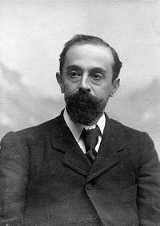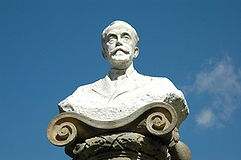
Joan Maragall
Encyclopedia

Catalan people
The Catalans or Catalonians are the people from, or with origins in, Catalonia that form a historical nationality in Spain. The inhabitants of the adjacent portion of southern France are sometimes included in this definition...
poet, journalist and translator, the foremost member of the modernisme
Modernisme
Modernisme was a cultural movement associated with the search for Catalan national identity. It is often understood as an equivalent to a number of fin-de-siècle art movements, such as Art Nouveau, Jugendstil, Secessionism, and Liberty style, and was active from roughly 1888 to 1911 Modernisme ...
movement in literature.
Life
Maragall's upper-class family was dedicated to the flourishing textile industryTextile industry
The textile industry is primarily concerned with the production of yarn, and cloth and the subsequent design or manufacture of clothing and their distribution. The raw material may be natural, or synthetic using products of the chemical industry....
in Barcelona, and after finishing school, Joan Maragall took on his father's job. Having never liked his family's trade, he decided to go to university instead where he studied law. Unfortunately, he never finished. Instead he dropped out of school and married Clara Noble, with whom he had 13 children. In 1904 he won all three prizes awarded by the Jocs Florals in Barcelona, and was proclaimed Mestre en Gai Saber. His private home in Sant Gervasi was bought by the Biblioteca de Catalunya and can be visited.
His grandson Pasqual Maragall would become mayor of Barcelona and subsequently President of Catalonia.
Work
Maragall's poetry was based on life and nature. Highly influenced by German-language authors such as Nietzsche, NovalisNovalis
Novalis was the pseudonym of Georg Philipp Friedrich Freiherr von Hardenberg , an author and philosopher of early German Romanticism.-Biography:...
and Goethe, all of which he translated into Catalan, his poetry went through decadentist
Decadentism
Decadentism was an Italian artistic style based mainly on the Decadent movement in the arts in France and England around the end of the 19th century. The main authors associated with decadentism were Antonio Fogazzaro, Italo Svevo, Giovanni Pascoli and Gabriele D'Annunzio...
and vitalist
Vitalism
Vitalism, as defined by the Merriam-Webster dictionary, is#a doctrine that the functions of a living organism are due to a vital principle distinct from biochemical reactions...
periods. He is best known for his 'theory of the living word', or teoria de la paraula viva, which advocated Nietzschean vitalism and spontaneous or even imperfect writing over colder and thought-over poetry.
In addition to his poetry writing, he also cultivated journalism in the main avantgarde magazines of the time: L'Avenç, Catalònia and Luz, from where he became the main figure of the Catalan modernisme.
He was also a supporter of Iberian Federalism.
Poetic works
- Poesies (1895)
- Visions i Cants (1900)
- Les Disperses (1904)
- Enllà (1906)
- Seqüències (1911)
- includes the poem La fageda d'en Jordà
See also
- ModernismeModernismeModernisme was a cultural movement associated with the search for Catalan national identity. It is often understood as an equivalent to a number of fin-de-siècle art movements, such as Art Nouveau, Jugendstil, Secessionism, and Liberty style, and was active from roughly 1888 to 1911 Modernisme ...
- Catalan literatureCatalan literatureCatalan literature is the name conventionally used to refer to literature written in the Catalan language. The Catalan literary tradition is extensive, starting in the Middle Ages....
- Casa Museu Arxiu Maragall

